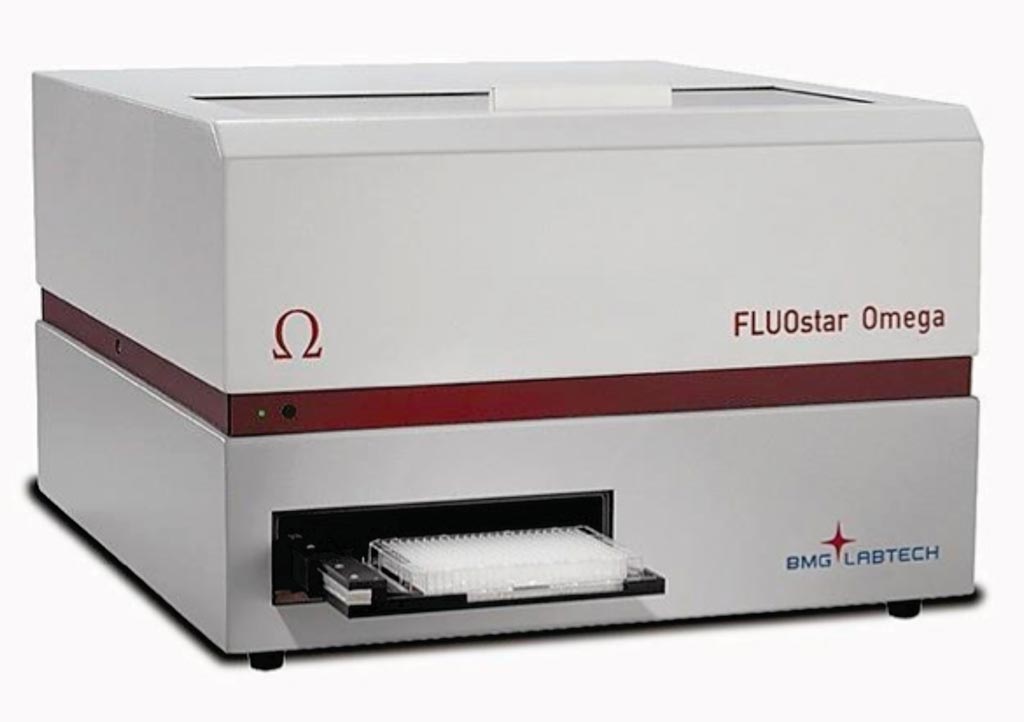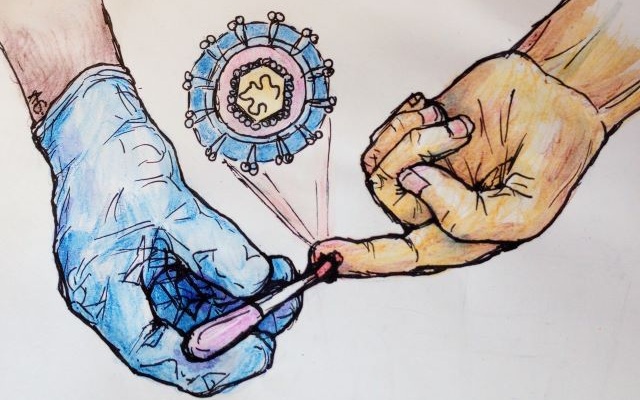Link Identified between Inflammation and Depression
|
By LabMedica International staff writers Posted on 20 Jun 2018 |

Image: The FLOUstar optima plate reader (Photo courtesy of BMG Labtech).
It is well established that people with both type-1 and type-2 diabetes have an increased risk of developing depression, a debilitating mental health disorder with potentially serious consequences, but the causes remain poorly understood.
Depression in type-1 diabetes patients is associated with higher levels of the inflammatory protein galectin-3, which is a key protein involved in promoting inflammatory immune system responses that are needed to repair tissue damage throughout the body, in response to injury or disease.
Scientists at Lund University (Lund, Sweden) and their colleagues carried out a cross-sectional study that included 283 type-1 diabetes (T1D) patients (56% men, age 18-59 years, diabetes duration ≥1 year). Depression was assessed by Hospital Anxiety and Depression Scale depression subscale. Blood samples, anthropometrics and blood pressure were collected, supplemented with data from medical records and the Swedish National Diabetes Registry.
Galectin-3 was analyzed using a commercial human DuoSet enzyme linked immunosorbent assay (ELISA) and supplementary ancillary kit. The ELISA analysis was performed and absorbance was measured at 450-580 nm in a FLOUstar optima plate reader. Concentrations of unknown samples were calculated using a four parameter logistic regression curve. The intra-assay coefficient of variation for the analysis was 4.3%. Galectin-3 levels equal to or greater than. 2.562 µg/L, corresponding to the 85th percentile, was defined as high galectin-3.
The scientists found that the median (quartile1, quartile3) galectin-3 was 1.3 µg/L (0.8, 2.9) for the 30 depressed patients, and 0.9 µg/L (0.5, 1.6) for the 253 non-depressed. Depression was associated with high galectin-3 in all the 283 patients (Adjusted odds ratio (AOR) 3.5), in the 161 men (AOR 3.4), and in the 122 women (AOR 3.9). HbA1c, serum-lipids, serum-creatinine, blood pressure, obesity, smoking, physical inactivity, cardiovascular complications, and drugs (antihypertensive, lipid lowering, oral anti-diabetic drugs, and antidepressants) were not associated with high galectin-3.
The authors concluded that their study was the first to show an association between depression and galectin-3. Depression was the only explored parameter associated with high circulating galectin-3 levels in 283 T1D patients. High galectin-3 levels might contribute to the increased risk for Alzheimer’s disease, cardiovascular and all-cause mortality observed in persons with depression. Potentially, in the future, treatment targeting galactin-3 might improve the prognosis for patients with high galectin-3 levels. The study was published on May 14, 2018, in the journal Endocrine Connections.
Related Links:
Lund University
Depression in type-1 diabetes patients is associated with higher levels of the inflammatory protein galectin-3, which is a key protein involved in promoting inflammatory immune system responses that are needed to repair tissue damage throughout the body, in response to injury or disease.
Scientists at Lund University (Lund, Sweden) and their colleagues carried out a cross-sectional study that included 283 type-1 diabetes (T1D) patients (56% men, age 18-59 years, diabetes duration ≥1 year). Depression was assessed by Hospital Anxiety and Depression Scale depression subscale. Blood samples, anthropometrics and blood pressure were collected, supplemented with data from medical records and the Swedish National Diabetes Registry.
Galectin-3 was analyzed using a commercial human DuoSet enzyme linked immunosorbent assay (ELISA) and supplementary ancillary kit. The ELISA analysis was performed and absorbance was measured at 450-580 nm in a FLOUstar optima plate reader. Concentrations of unknown samples were calculated using a four parameter logistic regression curve. The intra-assay coefficient of variation for the analysis was 4.3%. Galectin-3 levels equal to or greater than. 2.562 µg/L, corresponding to the 85th percentile, was defined as high galectin-3.
The scientists found that the median (quartile1, quartile3) galectin-3 was 1.3 µg/L (0.8, 2.9) for the 30 depressed patients, and 0.9 µg/L (0.5, 1.6) for the 253 non-depressed. Depression was associated with high galectin-3 in all the 283 patients (Adjusted odds ratio (AOR) 3.5), in the 161 men (AOR 3.4), and in the 122 women (AOR 3.9). HbA1c, serum-lipids, serum-creatinine, blood pressure, obesity, smoking, physical inactivity, cardiovascular complications, and drugs (antihypertensive, lipid lowering, oral anti-diabetic drugs, and antidepressants) were not associated with high galectin-3.
The authors concluded that their study was the first to show an association between depression and galectin-3. Depression was the only explored parameter associated with high circulating galectin-3 levels in 283 T1D patients. High galectin-3 levels might contribute to the increased risk for Alzheimer’s disease, cardiovascular and all-cause mortality observed in persons with depression. Potentially, in the future, treatment targeting galactin-3 might improve the prognosis for patients with high galectin-3 levels. The study was published on May 14, 2018, in the journal Endocrine Connections.
Related Links:
Lund University
Latest Clinical Chem. News
- Blood Test Could Predict and Identify Early Relapses in Myeloma Patients
- Compact Raman Imaging System Detects Subtle Tumor Signals
- Noninvasive Blood-Glucose Monitoring to Replace Finger Pricks for Diabetics
- POC Breath Diagnostic System to Detect Pneumonia-Causing Pathogens
- Online Tool Detects Drug Exposure Directly from Patient Samples
- Chemical Imaging Probe Could Track and Treat Prostate Cancer
- Mismatch Between Two Common Kidney Function Tests Indicates Serious Health Problems
- VOCs Show Promise for Early Multi-Cancer Detection
- Portable Raman Spectroscopy Offers Cost-Effective Kidney Disease Diagnosis at POC
- Gold Nanoparticles to Improve Accuracy of Ovarian Cancer Diagnosis
- Simultaneous Cell Isolation Technology Improves Cancer Diagnostic Accuracy
- Simple Non-Invasive Hair-Based Test Could Speed ALS Diagnosis
- Paper Strip Saliva Test Detects Elevated Uric Acid Levels Without Blood Draws
- Prostate Cancer Markers Based on Chemical Make-Up of Calcifications to Speed Up Detection
- Breath Test Could Help Detect Blood Cancers
- ML-Powered Gas Sensors to Detect Pathogens and AMR at POC
Channels
Molecular Diagnostics
view channel
Ultra-Sensitive Blood Biomarkers Enable Population-Scale Insights into Alzheimer’s Pathology
Accurately estimating how many people carry Alzheimer’s disease pathology has long been a challenge, as traditional methods rely on small, clinic-based samples rather than the general population.... Read more
Blood Test Could Predict Death Risk in World’s Most Common Inherited Heart Disease
Hypertrophic cardiomyopathy (HCM) is the world’s most common inherited heart condition and affects millions of people globally. While some patients live with few or no symptoms, others develop heart failure,... Read moreHematology
view channel
MRD Tests Could Predict Survival in Leukemia Patients
Acute myeloid leukemia is an aggressive blood cancer that disrupts normal blood cell production and often relapses even after intensive treatment. Clinicians currently lack early, reliable markers to predict... Read more
Platelet Activity Blood Test in Middle Age Could Identify Early Alzheimer’s Risk
Early detection of Alzheimer’s disease remains one of the biggest unmet needs in neurology, particularly because the biological changes underlying the disorder begin decades before memory symptoms appear.... Read more
Microvesicles Measurement Could Detect Vascular Injury in Sickle Cell Disease Patients
Assessing disease severity in sickle cell disease (SCD) remains challenging, especially when trying to predict hemolysis, vascular injury, and risk of complications such as vaso-occlusive crises.... Read more
ADLM’s New Coagulation Testing Guidance to Improve Care for Patients on Blood Thinners
Direct oral anticoagulants (DOACs) are one of the most common types of blood thinners. Patients take them to prevent a host of complications that could arise from blood clotting, including stroke, deep... Read moreImmunology
view channel
Ultrasensitive Liquid Biopsy Demonstrates Efficacy in Predicting Immunotherapy Response
Immunotherapy has transformed cancer treatment, but only a small proportion of patients experience lasting benefit, with response rates often remaining between 10% and 20%. Clinicians currently lack reliable... Read more
Blood Test Could Identify Colon Cancer Patients to Benefit from NSAIDs
Colon cancer remains a major cause of cancer-related illness, with many patients facing relapse even after surgery and chemotherapy. Up to 40% of people with stage III disease experience recurrence, highlighting... Read moreMicrobiology
view channel
New UTI Diagnosis Method Delivers Antibiotic Resistance Results 24 Hours Earlier
Urinary tract infections affect around 152 million people every year, making them one of the most common bacterial infections worldwide. In routine medical practice, diagnosis often relies on rapid urine... Read more
Breakthroughs in Microbial Analysis to Enhance Disease Prediction
Microorganisms shape human health, ecosystems, and the planet’s climate, yet identifying them and understanding how they are related remains a major scientific challenge. Even with modern DNA sequencing,... Read morePathology
view channel
Genetics and AI Improve Diagnosis of Aortic Stenosis
Aortic stenosis is a progressive narrowing of the aortic valve that restricts blood flow from the heart and can be fatal if left untreated. There are currently no medical therapies that can prevent or... Read more
AI Tool Simultaneously Identifies Genetic Mutations and Disease Type
Interpreting genetic test results remains a major challenge in modern medicine, particularly for rare and complex diseases. While existing tools can indicate whether a genetic mutation is harmful, they... Read more
Rapid Low-Cost Tests Can Prevent Child Deaths from Contaminated Medicinal Syrups
Medicinal syrups contaminated with toxic chemicals have caused the deaths of hundreds of children worldwide, exposing a critical gap in how these products are tested before reaching patients.... Read more
Tumor Signals in Saliva and Blood Enable Non-Invasive Monitoring of Head and Neck Cancer
Head and neck cancers are among the most aggressive malignancies worldwide, with nearly 900,000 new cases diagnosed each year. Monitoring these cancers for recurrence or relapse typically relies on tissue... Read moreTechnology
view channel
Pioneering Blood Test Detects Lung Cancer Using Infrared Imaging
Detecting cancer early and tracking how it responds to treatment remains a major challenge, particularly when cancer cells are present in extremely low numbers in the bloodstream. Circulating tumor cells... Read more
AI Predicts Colorectal Cancer Survival Using Clinical and Molecular Features
Colorectal cancer is one of the most common and deadly cancers worldwide, and accurately predicting patient survival remains a major clinical challenge. Traditional prognostic tools often rely on either... Read moreIndustry
view channel
BD and Penn Institute Collaborate to Advance Immunotherapy through Flow Cytometry
BD (Becton, Dickinson and Company, Franklin Lakes, NJ, USA) has entered into a strategic collaboration with the Institute for Immunology and Immune Health (I3H, Philadelphia, PA, USA) at the University... Read more



















